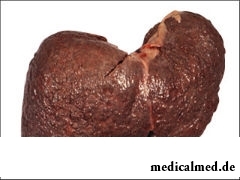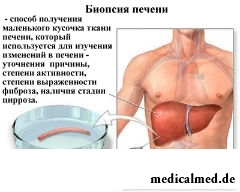





Cirrhosis
Cirrhosis is a consequence of a chronic disease of a liver and leads to loss of function of body. The liver affected with a disease dense, is reduced or increased in sizes, rough and hilly.
 Ascites (a liquid delay in an abdominal cavity) is the most frequent complication caused by cirrhosis and is connected with poor quality of life and the increased risk of development of infections. Others potentially life-threatening complications of the person are the confusion of consciousness, a hepatic coma and bleedings caused by a gullet varicosity.
Ascites (a liquid delay in an abdominal cavity) is the most frequent complication caused by cirrhosis and is connected with poor quality of life and the increased risk of development of infections. Others potentially life-threatening complications of the person are the confusion of consciousness, a hepatic coma and bleedings caused by a gullet varicosity.
Cirrhosis is irreversible process, its treatment is usually directed to prevention of the complications caused by it. Later stages of cirrhosis demand liver transplantation.
Cirrhosis is one of six diseases in the world because of which patients at the age of 35-60 years die.
Cirrhosis symptoms
Initial stages of a disease (class A) are not followed by symptoms as there are no complications yet. This time is ideal for elimination of an origin of a disease as the liver is the body capable to regeneration of the cells – it allows to keep healthy tissues of a liver and a message normal and a healthy lifestyle.
The main symptoms and symptoms of cirrhosis are:
- The stomach increased in volume;
- Changes of consciousness and behavior;
- Bleeding of gums;
- Nasal bleedings.
Also symptoms of cirrhosis are:
- Increased fatigue;
- Weight loss;
- Loss of appetite;
- Jaundice;
- Kcal of light color or decoloured;
- Urine darkening;
- Language of crimson color;
- Dyspepsia;
- Abdominal pains;
- Puffiness of shins;
- Vascular teleangiectasias;
- Skin itch;
- Bleedings;
- Frequent bacterial infections;
- Erythema of palms;
- Decrease in a libido;
- The stupid or aching pain in a liver;
- Gynecomastia at men.
Cirrhosis stages
The course of a disease occurs very slowly therefore in its current allocation of the following stages of cirrhosis is possible:
- Compensation stage – lack of symptoms, because of the strengthened functioning of a liver;
- Subcompensation stage – there are first symptoms of a disease which are expressed in weight loss, a loss of appetite, weakness and feeling of discomfort in right hypochondrium as the liver is not able to function at full capacity any more;
- The decompensation stage – appears jaundice, a syndrome of portal hypertensia and a hepatic coma which pose a threat for human life.
Diagnosis and treatment of cirrhosis
 Diagnosing of cirrhosis is carried out by the hepatologist or the gastroenterologist who after careful survey of the patient carry out biochemical analysis of blood, ultrasound examination of a liver and abdominal organs, blood test on markers of a viral hepatitis, gastroscopy, a computer tomography, a radio isotope research, and if necessary and a liver biopsy.
Diagnosing of cirrhosis is carried out by the hepatologist or the gastroenterologist who after careful survey of the patient carry out biochemical analysis of blood, ultrasound examination of a liver and abdominal organs, blood test on markers of a viral hepatitis, gastroscopy, a computer tomography, a radio isotope research, and if necessary and a liver biopsy.
After carrying out diagnosis and confirmation of the diagnosis of cirrhosis the treatment stage begins. This disease does not give in to full treatment, it is only possible to brake and slow down it development of complications. Treatment of cirrhosis consists in holding such therapeutic actions as:
- Reception of diuretic drugs;
- Purpose of a diet (lack of reception of fried and fat dishes, salt and alcoholic beverages);
- Reception of glucocorticoid hormones (at autoimmune disorders);
- Performing antiviral therapy (at a viral hepatitis);
- Reception of gepatoprotektor.
If at treatment of cirrhosis process of disease escalates, and there are complications, urgent hospitalization is necessary. Also at treatment of cirrhosis such surgical treatment as can be necessary:
- The shunting operations for creation of new ways for blood;
- Paracentesis – a puncture of an abdominal wall;
- Transplantation of a liver.
Caries is the most widespread infectious disease in the world to which even flu cannot compete.

Frosty air, fresh wind and easy snowball at most of Russians are associated with cheerfulness, health and cheerful entertainments, on to...
Section: Articles about health
The fatigue, sleep debt, disturbances of food, bad mood, vagaries of the weather – all these circumstances badly affect our appearance. Especially the person suffers: skin becomes flabby, loses healthy color, becomes covered by wrinkles, zones of hypostases and t appear...
Section: Articles about health
Bees – really unique beings. Practically all products of their life activity are used by the person. Since the most ancient times medicinal properties of honey and other substances received in the course of beekeeping are known. The fact that all these products are recognized not only national, but also official medicine is especially significant. About influence and routes of administration of bee "drugs" the speech in this article will also go....
Section: Articles about health
Statistically, can only one of ten of our compatriots brag of a decent condition of an oral cavity. On среднестатистич...
Section: Articles about health
Life of the modern child is extremely active and difficult. Information strain which is experienced by the school student and did not dream pupils of last times. Careful parents, wishing well to the children, will organize a set of additional classes in circles, sports...
Section: Articles about health
All got used long ago that, having addressed the plastic surgeon, it is possible to modify natural parameters of a figure or to minimize the damages put to appearance with ruthless time. Many people (preferential women) worldwide annually decide on operations such. However there are also much more exotic interventions which are carried out seldom so far and cost expensive very much. We bring the story about the most unusual of them to your attention....
Section: Articles about health
Sometimes it seems that modern society was divided into two camps: representatives of the first are sure that has to for contraception отвеч...
Section: Articles about health
For many women the word "fat" sounds as a sentence. In aspiration to an ideal figure they try to exclude, first of all, from the menu all dishes containing fats without having at the same time a clear idea of a role of these substances in exchange processes, and about an afterbirth...
Section: Articles about health
Scientists always aimed to offer fundamental explanations for medical problems. Their theories formed the basis of modern methods of treatment of the hardest pathologies and helped to save a set of lives. However stories are known also such theoretical constructions, following to which brought to mankind of a trouble and torture, ruined destinies and health of many people....
Section: Articles about health
History of cultivation of a buckwheat contains more than five thousand years. Grain which is received from this plant is used for пригото...
Section: Articles about health
Statistically, in Russia about 34% of citizens smoke. Most of consumers of tobacco has problems with health sooner or later. Not only smokers, but also their relatives suffer. Besides, cigarettes are expensive, and need of their acquisition heavy bry...
Section: Articles about health
(Xerostomia) many people consider feeling of a xerostomia small and easily removable inconvenience. This delusion: the symptom can demonstrate existence of serious diseases. It is worth to remember also that saliva performs important functions in an organism: clears the surface of teeth of a food plaque, growth of pathogenic microorganisms oppresses, normalizes acid-base balance, liquefies food and helps to split the carbohydrates which are contained in it. Chronic deficit слюн...
Section: Articles about health
Bathing in broths of medical flowers and plants (phytobathtub) was eurysynusic since Cleopatra who is a good judge of everything...
Section: Articles about health
The saying "the rich do not know how the other half lives" is known to all. In a broad sense it is that we can not always understand the person whose features of a state are unknown to us. If with physiological characters of diseases the situation is more or less clearly (having noticed and...
Section: Articles about health
The words "disease" and "patient" not without reason come from one root – "pain". As a rule, symptoms of illnesses thoroughly spoil to patients life. However from this rule there are exceptions. Some diseases are shown by signs which can cause even positive emotions. It is a pity only that the majority of such illnesses are heavy and incurable....
Section: Articles about health
Each of us faces from time to time that other people need the immediate help. We react to it on-raznomu:...
Section: Articles about health
Summer in the heat. Many are going to spend vacation abroad. Travelers the tender seas, rest on beaches wait, for sightseeing, campaigns on natural and cultural reserves. But, unfortunately, on vacation also problems about health can wait for us...
Section: Articles about health
Memory is an ability of the central nervous system to fix, keep and as necessary to reproduce information on knowledge or skills received by the person or an animal during life. The mechanism of this process is up to the end not studied....
Section: Articles about health
Since the moment when the child becomes a school student, his sight begins to be exposed to the strengthened loadings which are supplemented viewing...
Section: Articles about health
All parents are ready to what the baby often and pisat much. Since then, as the absorbing diapers strongly became current, keeping of the kid in dryness does not represent any problems. But if the grown-up kid continues to urinate in panties, parents of a nacha...
Section: Articles about health
Venereal diseases in medicine are called the infections which are transmitted preferential sexually, now they and are called - infections, sexually transmitted, or STD. Among them is also life-threatening. In spite of the fact that the majority of diseases such will respond to treatment, they are widespread everywhere, and there is no tendency to decrease in incidence. Besides, some of them promptly look younger: statistically, a third of young people at the age of 16-22 years of a str...
Section: Articles about health
You are office worker, the driver, the fan of winter sports or do not think of life without bicycle? You conduct a slow-moving image жизн...
Section: Articles about health
The unpleasant feelings connected with spring breakdown are familiar almost to each of us. Often happens that in March-April on the person weakness leans: he suffers from drowsiness, complains of bad mood, loss of interest in life and failures in affairs....
Section: Articles about health
Eyes – unique body on the structure thanks to which the person obtains about 80% of information on the world around: about a form, color, size, the movement, and also many other parameters of objects or phenomena. But whether much we know about the most valuable sense body which, according to the scientist Sechenov, provides us about one thousand various feelings a minute? Let's consider 10 most surprising facts about eyes and sight....
Section: Articles about health
Popular joke that there are no healthy people, and is nedoobsledovanny, most of us considers an honest truth, and put that...
Section: Articles about health
It would seem, about it there can be no disagreements: water is necessary for a human body for normal life activity, and about how and when it should be drunk, all know. It turned out that the situation is not absolutely so: for many years occur ве...
Section: Articles about health
About 10-15 years ago existence of the computer in the apartment of the Russian was considered as a rarity and office rooms were only at the first stage of equipment by these useful devices. Today practically in each house there is a computer (and often not one), and a regular user is already every our second compatriot. Convenience and efficiency of personal computers are undoubted, but the people working with them daily have to know also about health hazard which they can predstavlit...
Section: Articles about health
